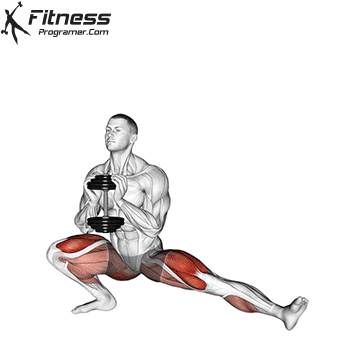Overview
The Dumbbell Cossack Squat is a lateral squat variation that enhances mobility, hip stability, and single-leg strength. The movement requires significant hip mobility, which can help improve flexibility in the hips and groin area. Holding a dumbbell adds resistance and helps maintain balance during the exercise. It’s particularly effective for developing unilateral strength since it focuses on one leg at a time.
It is an effective movement for athletes, lifters and general fitness enthusiasts who want to improve movement quality, strengthen balance and reduce the risk of injury.
How to Perform Dumbbell Cossack Squat

To perform the Dumbbell Cossack Squat correctly, follow these steps:
Hold a dumbbell vertically in front of your chest using both hands, like a goblet hold.
Stand with feet wide, toes slightly turned out and your core engaged.
Shift your weight to one side, bending the working knee and pushing your hips back while the other leg remains straight.
Keep your chest lifted and the dumbbell close to your body for balance.
Lower as far as mobility allows, keeping your heel flat on the bent leg and foot rotated slightly outward.
Push through the heel of the bent leg to return to standing, then repeat on the other side.
Tips for Proper Form
Keep your torso upright: Avoid collapsing forward by bracing your core and lifting the chest.
Maintain foot contact: Keep the heel of your squatting leg grounded throughout.
Use a wide stance: A wider stance allows a deeper and safer lateral descent.
Hold the dumbbell close: This adds resistance and helps with counterbalance.
Control the descent: Move slowly to stay in control and protect the knees and hips.
Common Mistakes
Rounding the back: Often caused by letting the dumbbell drift forward or weak core engagement.
Raising the heel too early: Keep the heel of the bent leg grounded for stability and full engagement.
Leaning too far forward: This shifts weight off the glutes and into the spine.
Rushing the movement: Fast reps reduce control and increase injury risk.
Not warming up: Cold hips and adductors are more prone to strain during deep lateral movement.
Benefits of the Dumbbell Cossack Squat
Improves lower body mobility: The deep lateral motion increases flexibility in the hips, groin, and ankles, promoting joint health and control.
Strengthens multiple muscle groups: It targets the quads, adductors, glutes, and hamstrings while also challenging the core for posture and stability.
Enhances balance and coordination: Lateral shifting under load builds proprioception and activates stabilizers that improve overall body control.
Increases flexibility: Regular practice stretches tight areas like the adductors, hamstrings, and hip flexors, improving movement quality.
Develops asymmetrical leg strength: One leg bears most of the load, helping correct imbalances and improve unilateral strength.
Improves lateral movement ability: It trains side-to-side movement patterns essential for athletes and supports injury prevention at the knees and hips.
Reduces spinal load: Holding a dumbbell in front places less stress on the spine compared to barbell squats while still building strength.
- Assists squat depth and form: Improved mobility from Cossack squats carries over to barbell squats and other lower-body lifts.
How to Incorporate Into Your Routine
The Dumbbell Cossack Squat is a versatile lower-body movement that fits a variety of training styles, from strength and hypertrophy to mobility and functional fitness. Here are multiple ways to include it:
- For Beginners: Perform 2 to 3 sets of 8 to 10 reps using just body weight or a light dumbbell to develop form, control, and joint mobility.
- For Hypertrophy: Use 3 to 4 sets of 10 to 12 reps per leg, gradually increasing dumbbell weight while focusing on a deep, controlled range of motion.
- For Strength: Complete 4 sets of 4 to 6 reps per leg using a heavier dumbbell. Prioritize slow tempo and even load distribution between sides.
- For Functional Training: Add 2 to 3 sets of 6 to 8 reps per leg using moderate weight to improve lateral movement patterns, balance, and joint control.
- For Circuit Training: Include it as a mobility-strength combo in your circuit. Do 10 reps per side with minimal rest to keep the heart rate elevated.
- For General Fitness: Perform 2 to 3 sets of 8 to 10 reps per leg using light to moderate weight, focusing on smooth transitions and proper depth.
- As a Mobility Drill or Warm-Up: Use bodyweight-only Cossack squats for 1 to 2 sets of 5 to 6 reps per side before squatting, running, or lower-body workouts.
Muscles Worked

Frequently Asked Questions
Is the Cossack Squat good for beginners?
Yes, but beginners should start with bodyweight only until they build sufficient mobility and control.
Should the heel stay flat or lift during the movement?
The heel of the bent leg should stay flat. The straight leg may lift slightly depending on ankle mobility.
What size dumbbell should I use?
Start with a light dumbbell, around 5 to 15 pounds, and focus on form before increasing weight.
Can I use a kettlebell instead of a dumbbell?
Yes, a kettlebell held in goblet position works just as well and may feel more comfortable for some.
How often should I do this exercise?
Two to three times per week is ideal for improving mobility and strength without overtraining.
